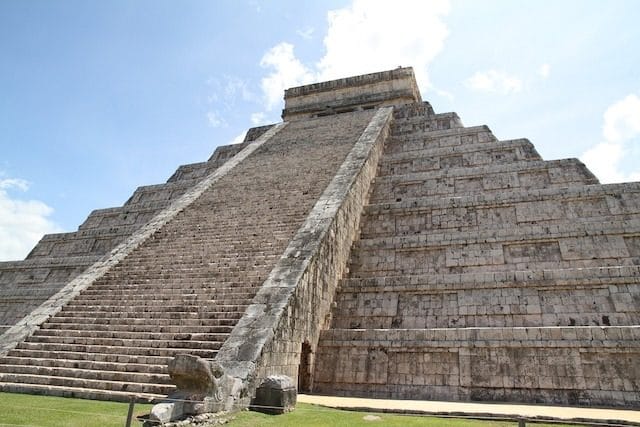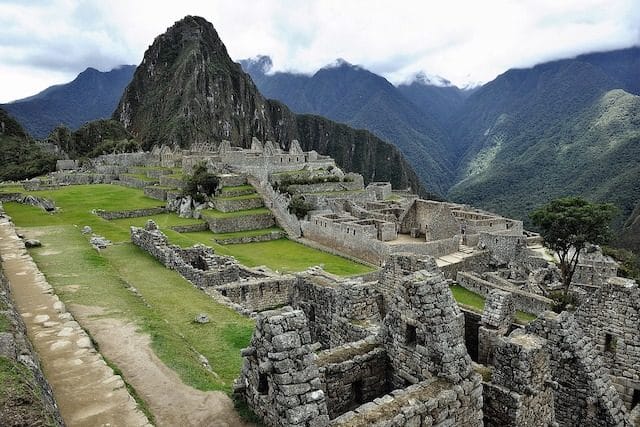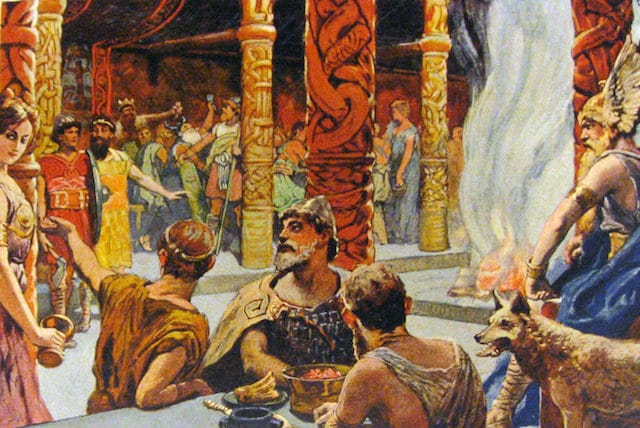What happens after we die? It’s a question we’ve all probably pondered at least once in our life, because it’s one of life’s greatest mysteries. And it will also probably stay that way until we leave this world ourselves.
Throughout history, different civilizations have also thought about what happens when someone dies. As varying cultures, they developed complex systems about what happens after we take our last breaths. While some of them are very different from each other, there are also a shocking amount of similarities between the afterlives of these cultures that were spread out all over the world.
10. The Mesopotamians

The Mesopotamia civilization was located in and around modern day Iraq, and it is considered the cradle of civilization.
The Mesopotamian afterlife was based on their creation of man story. Man was created by a deity named We-ilu, who mixed clay and blood from a god together. God’s blood made us part immortal, so when the body dies, it is buried and returns to clay. However, the immortal part remains on Earth as a spirit before traveling to the underworld. In the underworld, the soul passes through a demon-infested plain, then crosses the Khuber River with the assistance of a being called Silushi (“Quick, take [me] there!”), and they have to get through the seven gates of the netherworld city with the permission of the gatekeeper, Bidu (“Open Up!”).
Upon arrival in the underworld, the immortal part of the person was “judged” by the court of deities and then given a place in the afterlife. Even in heaven there was social structure, and where someone is placed in the great city of dead depended on two factors. The first was their social stature when they were alive, and the second depended on how their body taken care of after death. So in ancient Mesopotamia, you definitely wanted to treat your family nice while you were alive.
9. The Aztecs

The Aztec civilization emerged in the early 13th century in what is today modern Mexico. Their afterlife was different than many other cultures, because where a soul ended up depended on how the person died, and it was not based on the way they lived their lives.
The Aztec afterlife was split into four sections that were based on the four cardinal directions. In the east, there was an afterlife for women who died during childbirth. In that afterlife, they would help the sun emerge from the underworld. The people who died from diseases like leprosy, or were killed by lightning, or drowned, went to the afterlife in the south. It was a beautiful place where there was plenty to eat and drink.
In the north, the afterlife was called Mictlan and it was for people who died naturally, such as from old age. They had four years to make it through eight different levels of challenges. If they did, their soul would find peace on the ninth level.
As for warriors who died in combat, their heaven was in the west. In Aztec culture, the sun was important, and at times the Aztecs thought it was possible that the sun would enter the underworld and never re-emerge. So when a warrior died, he went to the heaven in the west, where he would help their god Huitzilopochtli, who was one of the two principal gods of the Aztecs and the sun and war god. Together, they would fight against the darkness to ensure that the sun would rise. They spent four years doing this, and then they returned to Earth as a hummingbird.
8. The Maoris

The Maori people arrived in what is today New Zealand in waves of canoes between 1250 and 1300 AD. When someone dies in the Maori culture, the spirit goes as far as someone can walk in New Zealand, which is the tip of Cape Reinga. There, the spirit slides down a Pohutukawa tree and into the ocean and eventually rejoins its ancestors. Their afterlife consisted of at least two different realms, sometimes as high as 12. Each level was ruled over by one of their gods. How the Maoris lived didn’t really effect which afterlife they went to because the Maoris did not believe that spirits were punished for their behavior on Earth.
The Maoris apparently weren’t overly concerned with the afterlife. What they did worry about was that someone’s spirit might not slide down the tree, and this could negatively affect people in the land of the living.
7. The Celts

The Celts were first mentioned in texts about 2,500 years ago, and what we know about their early days comes from writings by other civilizations, like the Greeks and the Romans. Because of that, it is highly debatable where the Celts’ real roots are. Many people believe they originated in the British Isles, while others believe they migrated there from mainland Europe.
Nevertheless, what we do know is that when the Celts migrated to what is today Ireland, they incorporated their religious beliefs with the inhabitants who already lived there. They believed that after death, their soul went to an afterlife called the Otherworld, which consisted of several different supernatural kingdoms. This included Tír na nÓg (“The Land of the Young”), Mag Mell (“The Plain of Honey”), and Tír Tairngire (“The Promised Land”). However, all the kingdoms were woven together, like the way scenes are meshed together in a dream, so they can be in the different kingdoms all at the same time.
6. Native Americans

It’s believed that the ancestors of the Native Americans migrated from Russia to modern day Alaska about 12,000 years ago. They settled across South and North America, and by the time Europeans reached the Americas, there were 50 million inhabitants; 10 million living in the United States. Since there were so many people, spread over such a big area of land, the tribes developed their own very unique cultures. North American tribes were generally divided into different cultural areas that all had a different view on the afterlife.
For the tribes of the Plains, they believed in an afterlife called the Happy Hunting Ground, where there was plenty of buffalo to hunt. The Pueblo Indians’ afterlife was just a continuation of this one; they simply went to another town where they meet up with dead people they knew in life. They also weren’t punished for anything they did in the previous life, because it was simply a continuation of that life. Similarly, the Omaha Indians of the Central Plains and the tribes of New England believed the afterlife was just a continuation of this one and there was no reason to punish the person in the afterlife.
Then, finally, there are the Cheyenne Indians of the Northern Plains, who believed that the spirit had to find a trail where the footprints all pointed in the same direction. They would follow the trail to the Milky Way until they got to a camp of the dead, which was in the stars, and they were greeted by dead friends and relatives when they got there.
5. The Ancient Chinese

In the ancient Chinese afterlife, when someone died, messengers carried their soul to Cheng Husand, who was the God of Walls and Moats. There, the soul was judged, and if the person was virtuous, then they would go on to paradise. However, only people who were kings on Earth got to experience true paradise. Other people went to a lower part of paradise, or they would be reincarnated.
There was also an underworld, called the Yellow Spring. Evil souls go there for a fixed amount of time, where they are punished for bad deeds. Once they have done their time, they are given the Elixir of Oblivion, and then they are reborn.
4. The Incans

The Incan empire started in the 12th century in the Andean area of South America. Their empire spanned from Ecuador to central Chile with about 12 million inhabitants.
Huk vida, the Incan term for the afterlife, was three horizontal levels. On top was Hanan Pacha, “The Upper World,” which is where people who lived righteous lives went after they died. Next was Kay Pacha, which literally means “This World.”
Finally, there was Uku Pacha, which is the “Below World” or the “Inner World.” It’s where people who weren’t good enough to go to Hanan Pacha go to live. Unlike in many other underworlds, Uku Pacha isn’t a place of punishment. Instead, it’s associated “with the feminine earth mother and the bones of the ancestors.”
Also, the Incans did not believe that the worlds were completely separated. Things like lightning were the Upper World connecting with This World, while mountains reached from This World upwards. As for the gateway to the Inner World, that was through holes and caves.
3. The Vikings

When a Viking warrior died, it was possible for him to go to Valhalla, which means “The Hall of the Fallen.” It is a great palace and the roof is made of shields, and it’s guarded by wolves and eagles. When a warrior gets there, he is welcomed by the god Odin, and they share a glass of mead, which is a sweet honey-based drink.
In Valhalla, the fallen warriors eat freshly slaughtered boar, which is made whole again at evening. Also, there is unlimited mead. Yep, that’s right: in Valhalla, it’s an open bar. Best afterlife ever.
They also constantly battled each other. However, it was for sport, because they needed to keep training for their doomsday, called Ragnarök. When that happens, the warriors will exit the 540 doors of the hall to fight alongside Odin against Norse mythology’s most infamous wolf, Fenrir, who is the son of the god Loki and the giantess Angrboða. It was said that when a brave warrior dies, it is because Odin needed another warrior to fight during Ragnarök. So… maybe not quite the best afterlife ever. But still, open bar!
However, not every warrior made it to Valhalla. The warrior had to be an honorable person and they had to die in battle. This gave them strong motivation to give it their all in their battles, because they had no fear of death; they were going to a better place if they died.
As for people who didn’t die on the battlefield, there were different afterlives. For example, the Vikings were seafaring people, and if someone died at sea or drowned, they would go to the hall of the sea god Aegir. He was known for hosting parties for the gods.
If someone wasn’t honorable, they went to a hall that has woven snakes which spew rivers of venom. People who got sick or, Odin forbid, died of old age had the worst afterlife. They went to a foggy place where they had to eat terrible food with the goddess Hel, who is decaying.
Finally, there are warriors who weren’t lucky enough to make it to Valhalla, which was supposedly half the soldiers. The other half went to a meadow or field ruled over by the goddess Freyja, called Fólkvangr. Life was more peaceful there than Valhalla. They made art, told stories, and were companions to women who died as maidens.
2. The Greeks and The Romans

The Greeks and the Romans share a very similar afterlife, because Romans borrowed the Greek system of gods. So for simplicity’s sake, we’ll just look at the Greek’s afterlife.
In Greek mythology, when someone dies they go to the Underworld, which is deep in the Earth. It’s ruled by Hades and his queen, Persephone. Hades is always looking for more souls, and there is always room for more.
The soul’s guide in the Underworld is Hermes, an Olympian god who is the son of Zeus. The guide is needed because the Underworld is surrounded by five rivers; the Acheron (“River of Woe”), the Cocytus (“River of Lamentation”), the Phlegethon (“River of Fire”), the River Styx (“River of Hate”), and the Lethe (“River of Forgetfulness”).
To get the Underworld, a soul had to be ferried across the Rivers Styx by the boatman Charo, if they had the fare. The fare needed to be placed on the deceased people’s lips by relatives. If someone doesn’t have the fare, they stayed in limbo between the two worlds.
On the other side of the river is a giant three headed dog named Cerberus. He let’s people in, but let’s very few leave. Kind of like a mythological roach motel. After entering the gates, there are three judges named Rhadamanthus, Minos, and Aeacus, and the deceased tell their life stories. Then there are three possible outcomes. The first is they go to the Fields of Asphodel, which is where most people go. It’s a gloomy and gray place where souls wander around aimlessly. Kind of like Seattle. The second is for the souls of heroes and the blessed dead, who went to Elysium, which was considered a paradise.
On the other end of the spectrum from Elysium is the Pit of Tartarus, which is located in the deepest part of the Underworld. It also sounds like ‘tartar sauce’ so you know it can’t be good. It’s the same place where the 12 Olympian gods held the Titans, the former rulers of the world. It’s a miserable place that’s dark and cloudy all the time. There are even storms that sweep people up, and they can’t touch the ground for at least a year.
1. The Egyptians

When people in ancient Egypt died, they believed that their soul, called a ba, would return periodically to the body. That’s why they mummified the remains. When the ba left the body, it traveled through the afterlife and had to pass through several gates, all guarded by deities. Once they got through the gates, the ba entered the Hall of Two Truths.
The hall is long, and supported by columns. At the end of the hall is the god of the underworld, Osiris. Surrounding the ba are 42 gods with names like Bone-Breaker and the Eater of Entrails. The ba then must proclaim the sins they did not commit to the specific god. For example, the ba has to turn to the god Fire-embracer and say, “O Fire-embracer who came forth from Kheraha, I have not robbed.” And the ba would go on and do a specific sin for a specific god.
One of the worries for the ancient Egyptians was knowing what sin was associated with what god. Also, they needed to know what sins they couldn’t commit. So scrolls called the Book of the Dead were developed as a guide to the afterlife. What’s interesting is that there was no standard Book of the Dead and often variations were quite drastic.
After getting through the Hall of Two Truths, the ba goes through another ceremony called the “Weighing of the Heart.” The ancient Egyptians believed that the heart was a record of the deceased person’s life. The heart was put on a scale and on the other scale was the feather from the goddess Ma’at, which was a symbol for truth and justice. If the feather was heavier than the heart, then the person wasn’t virtuous and they were fed to Ammut the Devourer. If the scale balanced, then they were taken to Osiris and welcomed to the afterlife called the Field of Reeds, where they were given a plot of land that they were expected to work. So, you know… not quite as awesome an afterlife as Valhalla, with its open freaking bar.
Robert Grimminck is a Canadian freelance writer. You can friend him on Facebook, follow him on Twitter, follow him on Pinterest or visit his website, or his true crime YouTube channel.